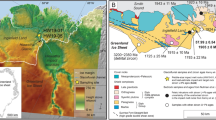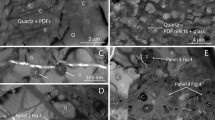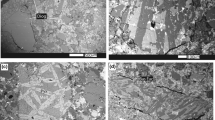Abstract
The 1750-m-diameter, bowl-shaped Talemzane impact structure in Algeria is emplaced in Senonian or Eocene flint-bearing limestones. Field studies reveal a thin layer of light-colored polymict breccia with rounded, dark inclusions beneath a limestone megablock zone located at the top of the crater rim. The matrix of the rounded, dark inclusions consists of Si-rich glass and microcrystalline calcite. The latter is characterized by high contents of Si and Al suggesting rapid crystallization of the calcite from a melt. Backscattered electron imagery shows textural evidence for liquid immiscibility between the CaCO3-rich and Si-rich glass of the matrix in the form of intermingling of calcite with Si-rich glass, coalesced blebs within silicate glass, individual calcite blebs within Si-rich glass, carbonate spherical globules in fresh Si-rich-glass, and sharp menisci between silicate and calcite blebs. These features are interpreted as evidence of impact melting of limestone and flint. The low totals of the Si-Al-Mg-rich glasses suggest that they contain significant amounts of volatiles. X-ray diffraction analyses indicate partial alteration of the Si-Mg-Al-rich glass to phyllosilicates.







Similar content being viewed by others
References
Agrinier P, Deutsch A, Schärer U, Martinez I (2001) Fast backreactions of shock-released CO2 from carbonates: an experimental approach. Geochim Cosmochim Acta 65:2615–2632
Baratoux D, Melosh HJ (2003) The formation of shatter cones by shock interference during impacting. Earth Planet Sci Lett 216:43–54
Belhai D, Merle O, Vincent P, Devouard B, Afalfiz A (2006) Etat des connaissances et mise au point sur les cratères météoritiques du Sahara algérien, des indications de pièges à hydrocarbures? Bulletin du Service Géologique de 1 ‘Algérie 17:95–112
Boslough MB, Ahrens TJ, Vizgirda J, Becker RH, Epstein S (1982) Shock-induced devolatilization of calcite. Earth Planet Sci Lett 61:166–170
Brady LF (1954) The crater of Talemzane in Algeria. Sky and Telescope 297–298
Claeys P, Heuschkel S, Lounejeva-Baturina E, Sanchez-Rubio G, Stoeffler D (2003) The suevite of drill hole Yucatan 6 in the Chicxulub impact crater. Meteorit Planet Sci 38:1299–1317
Dietz RS (1968) Shatter cones in cryptoexplosion craters. In: French BM, Short NM (eds) Shock metamorphism of natural materials. Maryland: Mono Book Corp, Baltimore, pp. 267–258
Dressler BO, Reimold WU (2001) Terrestrial impact melt rocks and glasses. Earth-Sci Rev 56:205–284
Freestone IC, Hamilton DL (1980) The role of liquid immiscibility in the genesis of carbonatites- an experimental study. Contrib Mineral Petrol 73:105–117
French B M (1998) Traces of catastrophe: a handbook of shock metamorphic effects in terrestrial meteorite impact structures Houston, Texas
Graup G (1999) Carbonate-silicate liquid immiscibility upon impact melting: Ries crater, Germany. Meteorit Planet Sci 34:425–438
Hörz F, Mittlefehldt DW, See TH, Galindo C (2002) Petrographic studies of the impact melts from meteor crater, Arizona. Meteorit Planet Sci 37:501–531
Hörz F, Archer PD, Niles PB, Zolensky ME, Evans M (2015) Devolatilization or melting of carbonates at meteor crater, AZ? Meteorit Planet Sci 50:1050–1070
Ivanov BA, Deutsch A (2002) The phase diagram of CaCO3 in relation to shock compression and decompression. Phys Earth Planet Inter 129:131–143
Jones AP, Claeys P, Heuschkel S (2000) Impact melting of carbonates from the Chicxulub crater. In impacts and the early earth. In: Gilmour I, Koeberl C (eds) Lecture notes in earth sciences, vol 91. Springer-Verlag, Berlin, pp. 343–361
Karpoff R (1953) The meteorite crater of Talemzane in southern Algeria. Meteoritics 1:31–38
Karpoff R (1954) Un cratère de «météorite» à Talemzane dans le Sud Algérien. Proceedings C.R.Congrès Geol. Intern. pp.233–241
Kieffer SW, Simonds CH (1980) The role of volatiles and lithology in the impact cratering process. Rev Geophys Space Phys 18:143–181
Kjarsgaard BA, Hamilton DL (1989) The genesis of carbonatites by immiscibility. In Carbonatites: Genesis and Evolution. Unwin Hyman, London. pp. 388–404
Koster van Groos AF, Wyllie PJ (1966) Liquid immiscibility in the system Na2O-Al2O3-SiO2-CO2 at pressures to 1 kilobar. Am J Sci 264:234–255
Lambert P, Mchone JE, Dietz RS, Houfani M (1980) Impact and impact-like structures in Algeria, part I, four bowl-shaped depressions. Meteoritics 15:157–179
Langenhorst F (2002) Shock metamorphism of some minerals: basic introduction and microstructural observations. Bulletin of the Czech Geological Survey 77:265–282
Melosh HJ (1989) Impact cratering: a geologic process. Oxford University Press, New York 245
O’Keefe JD, Ahrens TJ (1989) Impact production of CO2 by the cretaceous/tertiary extinction bolide and the resultant heating of the earth. Nature 338:247–249
Osinski GR, Spray JG (2001) Impact-generated carbonate melts: evidence from the Haughton structure, Canada. Earth Planet Sci Lett 194:17–29
Osinski GR, Schwarcz HP, Smith J, Kleindienst MR, Haldemann AFC, Churcher CS (2007) Evidence for a 100–200 ka meteorite impact in western Egypt. Earth Planet Sci Lett 253:378–388
Osinski GR, Grieve RAF, Collins GS, Marion C, Sylvester P (2008a) The effect of target lithology on the products of impact melting. Meteorit Planet Sci 43:1939–1954
Osinski GR, Grieve RAF, Spray JG (2008b) Impact melting in sedimentary target rocks: an assessment. In: Evans KR, Horton W, King Jr DK, Morrow JR, Warme JE (eds) GSA Special Publication 437The sedimentary record of meteorite impacts. Geological Society of America, Boulder, pp. 1–18
Pratesi G, Morelli M, Rossi AP, Ori GG (2005) Chemical compositions of impact-melt breccias and target rocks from the Tenoumer impact crater, Mauritania. Meteoritics& Planetary Science 40:1653–1672
Reimold WU, Koeberl C (2014) Impact structures in Africa: a review. J Afr Earth Sci 93:57–175
Roedder E (1978) Silicate liquid immiscibility in magmas and in the system K2O-FeO-Al2O3-SiO2: an example of serendipity. Geochim Cosmochim Acta 42:1597–1617
Skála R, (2002) Shock-induced phenomena in limestones in the quarry near Ronheim, the Ries Crater, Germany, Bulletin of the Czech Geological Survey 77: 313–320
Stöffler D (1977) Research drilling Nördlingen 1973: Polymictbreccias, crater basement, and cratering model of the Ries impact structure. Geologica Bavarica 75:443
Stöffler D, Grieve RAF (2007) Impactites. In: Fettes D, Desmons J (eds) Metamorphic rocks. Cambridge University Press, Cambridge, pp. 82–92
Stöffler D, Artemieva NA, Wünnemann K, Reimold WU, Jacob J, Hansen BK, Summerson IA (2013) Ries crater and suevite revisited. Observations and modeling part I: observations. Meteorit Planet Sci 48:515–589
Treiman AH (1989) Carbonatite magma: properties and processes. In Carbonatites: Genesis and Evolution. Unwin Hyman, London. pp. 89–104
Wünnemann K, Collins GS, Osinski GR (2008) Numerical modelling of impact melt production on porous rocks. Earth and. Planet Sci 269:530–539
Acknowledgments
This work was funded by Laboratoire de Géodynamique, de Géologie de l’Ingénieur et Planétologie (LGGIP), Université des Sciences et de Technologie Houari Boumedienne, Algiers, Algeria, and ISTeP, Paris, France. The authors thank the many individuals and institutions that have facilitated fieldwork at Talemzane structure. We are indebted to French. Bevan. M. for his critical and fruitful discussions that helped to improve the quality of this manuscript. We thank Kord Ernstson, for detailed and constructive review.
Author information
Authors and Affiliations
Corresponding author
Rights and permissions
About this article
Cite this article
Sahoui, R., Belhai, D. & Jambon, A. Impact-generated carbonate melts in the Talemzane impact structure (Laghouat, Algeria). Arab J Geosci 9, 641 (2016). https://doi.org/10.1007/s12517-016-2665-6
Received:
Accepted:
Published:
DOI: https://doi.org/10.1007/s12517-016-2665-6




